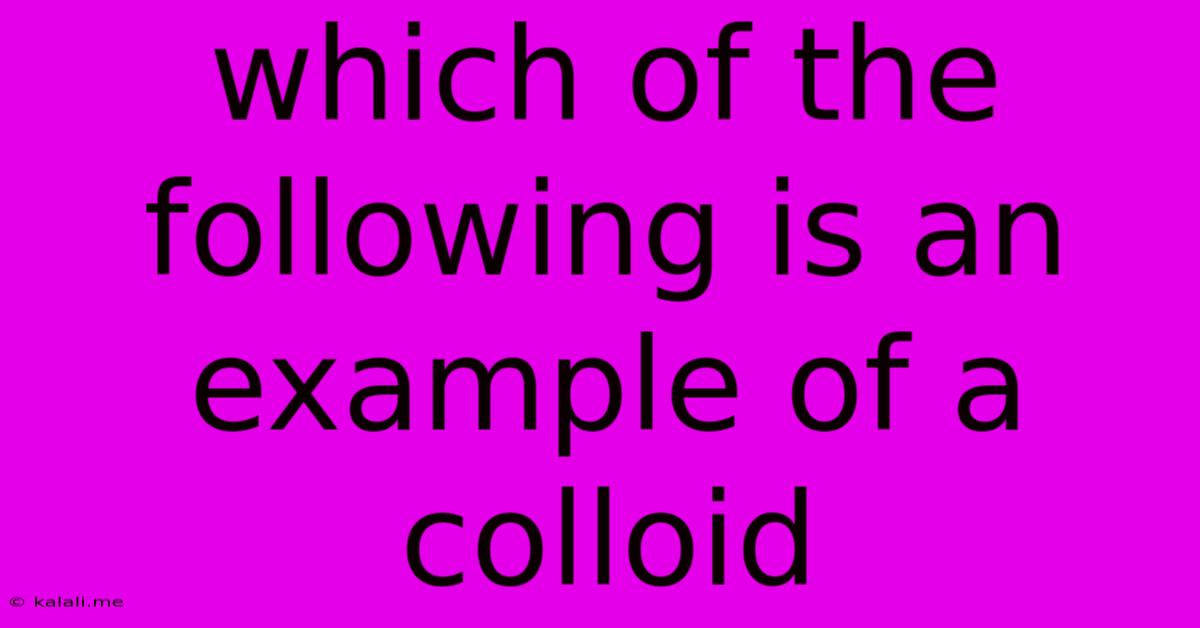Which Of The Following Is An Example Of A Colloid
Kalali
Jun 14, 2025 · 3 min read

Table of Contents
Which of the Following is an Example of a Colloid? Understanding Colloidal Dispersions
Colloids are everywhere, from the food we eat to the products we use daily. Understanding what defines a colloid is crucial to grasping many scientific and everyday phenomena. This article will delve into the characteristics of colloids and provide clear examples to answer the question: which of the following is an example of a colloid? We'll explore various substances and explain why some fit the definition while others don't. This will help you confidently identify colloids in different contexts.
What is a Colloid?
A colloid is a mixture where one substance is dispersed evenly throughout another. The key difference between a colloid and a solution lies in the size of the dispersed particles. In a solution, the particles are dissolved and incredibly small (ions or molecules), while in a colloid, the dispersed particles are much larger, ranging from 1 to 1000 nanometers in diameter. These larger particles are called colloidal particles or dispersed phase, and the medium they are dispersed in is called the dispersion medium. Because of this particle size, colloids exhibit unique properties, such as the Tyndall effect (scattering of light).
Key Characteristics of Colloids:
- Particle Size: 1-1000 nanometers. This is the defining characteristic.
- Heterogeneous Mixture: Although appearing uniform, colloids are heterogeneous mixtures.
- Tyndall Effect: Colloids scatter light, making a beam of light visible when shone through them. Solutions do not exhibit this effect.
- Non-Settling: Colloidal particles don't settle out of the dispersion medium over time.
Examples of Colloids:
Now, let's consider some examples and determine if they are colloids:
1. Milk: Milk is a classic example of a colloid. The fat globules (the dispersed phase) are dispersed throughout the water (the dispersion medium). It exhibits the Tyndall effect and the fat globules don't settle out easily.
2. Mayonnaise: This creamy condiment is another excellent example. Oil droplets are emulsified (dispersed) within water, creating a stable colloid.
3. Fog: Fog is a colloid of tiny water droplets dispersed in air. The water droplets are large enough to scatter light, making fog appear cloudy.
4. Blood: Blood is a complex colloid containing various cells and proteins dispersed in plasma. The presence of these dispersed particles makes it a colloid.
5. Paint: Paint is a colloid of pigment particles dispersed in a liquid medium (usually oil or water). The pigment particles are relatively large and remain suspended within the liquid.
6. Gelatin: Gelatin is a colloid of protein molecules dispersed in water. This creates a gel-like structure.
Substances that are NOT Colloids:
To better understand colloids, it's helpful to see what isn't a colloid:
- Saltwater: Salt dissolves completely in water, forming a true solution, not a colloid. The particles are too small.
- Sugar Water: Similar to saltwater, sugar dissolves completely into individual molecules, forming a solution.
- Sand in Water: This is a suspension, not a colloid. The sand particles are much larger than the colloidal range and will settle out over time.
Conclusion:
Many everyday substances are colloids. By understanding the defining characteristics of particle size, the Tyndall effect, and the stability of the dispersion, you can easily identify colloids. Milk, mayonnaise, fog, blood, paint, and gelatin are all excellent examples. Remember, the key is the size of the dispersed particles – in the range of 1 to 1000 nanometers. This article has provided a comprehensive overview of colloids, enabling you to confidently answer the question: which of the following is an example of a colloid?
Latest Posts
Latest Posts
-
Example Of Solid Dissolved In Solid
Jun 14, 2025
-
Air Pressure At Sea Level Is Equal To
Jun 14, 2025
-
What Is The Opposite Of Reluctant
Jun 14, 2025
-
Brass Is A Mixture Of What
Jun 14, 2025
-
Which Of The Following Are Pure Substances
Jun 14, 2025
Related Post
Thank you for visiting our website which covers about Which Of The Following Is An Example Of A Colloid . We hope the information provided has been useful to you. Feel free to contact us if you have any questions or need further assistance. See you next time and don't miss to bookmark.